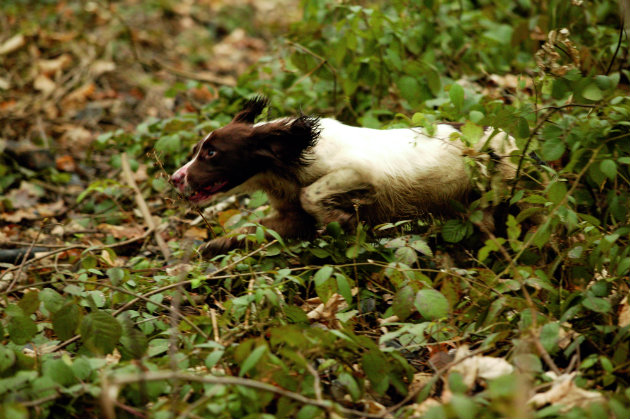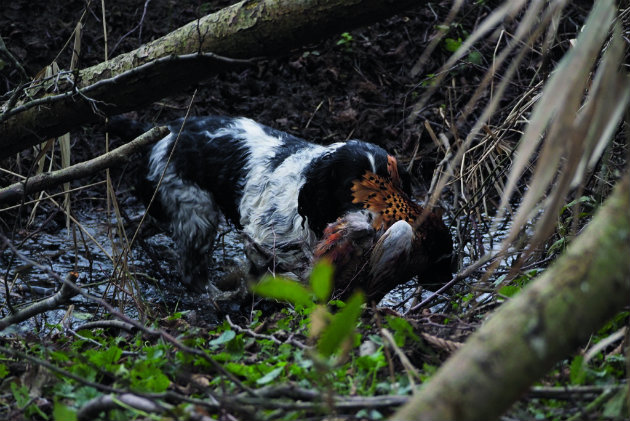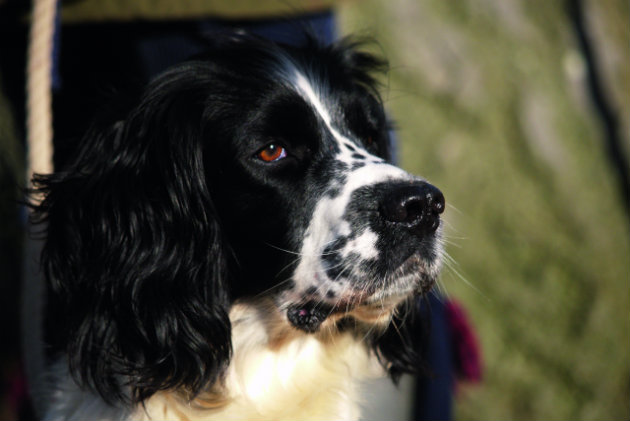Win CENS ProFlex DX5 earplugs worth £1,149 – enter here
Are dogs really colour-blind?

ONE OF THE extraordinary things about dogs is that they may be able to mark a falling bird 200 yards away, but they will run straight past a dead bird lying in the open without seeing it. It’s a reminder that a dog’s eyesight is very different from our own.
Dogs are good at following moving objects
Despite being near-sighted, dogs can completely miss spotting a dummy or a dead bird just a few feet from them, unless they scent it first. On the other hand, their eyes have large pupils and a wide field of view, which means they are good at following moving objects, such as a running hare or a falling pheasant, even if it is a long way away.
Perhaps the commonest misconception about dogs is that they are colour-blind. They’re not, but they see the world very differently to us. Humans have three different colour-sensitive cone cells in their retina (red, blue and green), but dogs have just two (yellow and blue). This means that they are unable to distinguish red, green or yellow objects based on their colour alone because these three colours look the same to them. However, if you test a dog using red, green and yellow dummies, you may well find that it can differentiate between them if one is brighter than the others. Think of it as different shades of grey.

A dog’s sense of smell is more acute than its eyesight
Dogs’ vision is excellent at night
As anyone who has walked their dog at night will know, dogs see much better in the dark than we do. This is because they have an abundance of light-gathering rods in their retina, which gives them excellent night vision. They also have reasonable binocular vision — as do humans and owls, but not hares or hens — and this is what allows them the depth perception or, from a gundog viewpoint, the ability to mark where a bird has dropped.
However, a dog’s eyesight is not one of its strongest senses. Dogs have a fantastic sense of smell and their hearing is pretty acute, too. As dogs age, they lose this hearing, and their eyesight becomes less sensitive, but I have never seen any evidence to suggest that their sense of smell fades.
An inherited disease causing blindness
Progressive retinal atrophy (PRA) is one of the most unpleasant of canine diseases. It’s an inherited disease and dogs that are affected will eventually go blind. The retina is the equivalent of the film in a camera or, in digital terms, the sensor. In a dog with PRA, the rod cells in the retina are programmed to die. This happens progressively, with both eyes affected simultaneously. It’s not painful, but it does lead to eventual blindness.
Just to complicate matters, many dogs are carriers of PRA, though they will never go blind themselves. Testing for PRA is one of the most important health checks that can be taken, though some breeds, such as Labradors, are much more seriously affected than others.
The dangers of working a dog in brambles
Though most of us in the gundog world are only too well aware of the perils of PRA, how many of us are mindful of the dangers to a dog’s eyes when working them in thick brambles? A trialling friend of mine brought this to my attention in a recent email.

A dog’s eye is protected by an upper, lower and third eyelid – as well as by tears
“I had a bit of a wake-up call yesterday,” he wrote. “I took my best springer bitch, Merida, to an eye specialist — one of the best in the country. Merida is six years old and has not run in many trials but she is very good in brambles. She had a small injury that my vet thought should be checked out. The specialist did a thorough examination of her eyes and said that they were both like war zones. I was horrified. They both had multiple corneal scars and one had a tiny foreign body in it that had healed over.
“Though she was given the all-clear, I felt terrible and it has made me think hard about the justification of running my dogs in competitions in heavy brambles. I have often thought that some spaniel triallers see the bloodied eyes of their dogs after a run in brambles as a bit of a badge of honour, similar to terriermen. It has certainly made me think about competing with my dogs in such conditions. Merida has one run left this season, in light cover, then I will retire her. I wonder what the eyes of a lot of these trialling dogs would be like if they were examined?”
Should you fit your spaniel with goggles?
A good question, and it’s not difficult to guess at the answer. Dogs’ eyes are protected by upper and lower eyelids, by a third eyelid or “haw”, and by tears. The eyelids are lubricated by a thin layer of mucous to avoid irritating the surface of the cornea. This, you would have thought, would give them adequate protection, but by asking a dog to hunt hard in brambles we are encouraging what is basically unnatural behavior, and one for which they are clearly not sufficiently protected.
Short of fitting our spaniels with goggles there’s no obvious solution to the problem, other than being aware of the dangers that brambles pose and keeping exposure to them at a minimum.
Related Articles
Get the latest news delivered direct to your door
Subscribe to Shooting Times & Country
Discover the ultimate companion for field sports enthusiasts with Shooting Times & Country Magazine, the UK’s leading weekly publication that has been at the forefront of shooting culture since 1882. Subscribers gain access to expert tips, comprehensive gear reviews, seasonal advice and a vibrant community of like-minded shooters.
Save on shop price when you subscribe with weekly issues featuring in-depth articles on gundog training, exclusive member offers and access to the digital back issue library. A Shooting Times & Country subscription is more than a magazine, don’t just read about the countryside; immerse yourself in its most authoritative and engaging publication.







